QuestionQUESTION: Hello. I've had a bearded dragon for a month now. She was 5 months when I got her from the pet store. I've fed her romaine lettuce in the mornings and evenings and 15-20+ small crickets each afternoons the pet store told me to (I switched to dandelion greens a couple of days ago though for nutrition). She is currently shedding and has once before. I bought her and it included the set up she was in...30 gal tank, sand, branch, water dish, white coil lamp and purplish heat lamp. I keep the heat lamp on 24/7 and the white light on 14 hrs a day. A couple of days ago she slowed eating and only ate a couple of crickets yesterday and didn't touch her greens. She won't eat today. She seems really tired. All she does is lay on her branch under the heat. I do have her out a lot during the day just riding on my shoulder or in my shirt. Sometimes she makes a sound almost like she's clearing something out of her throat as she sticks out her tongue and she does poop (stinky). Do you think there is something wrong with her since she's not really eating and seems tired? Thank you, in advance, for your answer.
ANSWER: Hi Leah,
I'm going to include a basic care sheet that I wrote to help people out. Be sure to read the section on the uvb lighting..
the uvb bulb you are using is not recommended at all. It does not put out the uvb in the way a beardie needs it. Also, double check your temperatures. Many times between improper uvb and temperatures, they will stop eating. With having her out a lot, many times they cool down too much. Remember, they can only heat as much as the air temperature is.
Since you are using sand in the tank, she may be one that shouldn't have it in there..she may be eating the sand while catching insects. Also, the calci sand or other sands that claim to be edible, aren't. She may also just need a good drink..try offering water from an eye dropper or syringe. Also, giving her a bath in warm water may get her to drink and clear out her throat. The stinky poop, if different that it used to be, that can be a sign of internal parasites.
I would cut her daylight/night to 12/12 or even 10 day/14 night ..many people go with what is happening outside...meaning sunrise/sunset for light schedule.
On the diet, its best to offer a variety of greens on a daily basis. More on foods in the care sheet below. Dandelion greens, in addition to other dark, leafy greens is recommended. Even tough it may sound odd, the dandelion greens may have upset her stomach a bit...try offering collard greens and other greens without the dandelion greens. Reptiles can and do have foods that don't agree with them.
If after making any needed changes, she still doesn't seem right, I would have a vet check her out and for sure get a fecal check done.
BASIC BEARDED DRAGON CARE:
HOUSING:
For an adult bearded Dragon, a 50 -55 gallon is the smallest recommended tank. For a baby, nothing less than a 30 gallon tank will work for a very short time, so its best to just start out with the adult sized tank....you can add rocks and branches for climbing, being sure to not stack rocks too high to prevent them toppling over. Branches need to be secure. They like to have a hide log or cave too!! All items brought from outside need to be cleaned well before placing them in the BD's tank. To clean them, there are a few methods: to wash in a bleach solution of 1/4 cup of bleach to 1 gallon of water. Let them soak for about an hour, rinse them in hot water several times and then let them dry in the sun until completely dry. If the items are small enough, they can be baked in an over at 200 degrees for about 2 hours, check often to be sure they are not starting to burn. The items can also be boiled(simmered) for 30 minutes or so and then allowed to dry completely before placing in the tank. I also suggest washing any pet store items such as caves, rocks, branches, etc before placing in the tank as that if the store would happen to have mites they can also be on the items we purchase. Any of the above methods are acceptable for cleaning. CAUTION!!! On store bought branches...be VERY careful with the driftwood pieces that have the holes in them!!! Be sure the holes are small as that if the holes are large, the BD MAY be able to get his head in them but not able to get it back out!!! A secure screen top is necessary for bearded dragons as that also they do not require much height for climbing..they can and do climb!! NEVER USE HEAT ROCKS OR HEATED CAVES!!! They malfunction and cause severe burns and even death!!!!
SUBSTRATES:
Young bearded dragons MUST be kept on paper towels, newspaper or other non particulate(loose) substrate to prevent them from getting any loose substrate into their mouth and swallowing it which can and does cause intestinal blockages.Once the BD is over 10 inches, some people have had good luck using play sand mixed with 50% of peat moss. I prefer the safe substrate of the newspaper, or other non particulate substrate to prevent any problems and also for ease of cleaning.
LIGHTING:
BD's need UVB, which is the special lights that come in fluorescent tubes or special screw in bulbs(mercury vapor)that are designed to produce uvb and heat. The tubes do not produce heat. UVB is needed by the BD to be able to absorb the calcium in the foods they eat. Without the uvb, they will develop metabolic bone disease. With the tubes, they must say that they produce BOTH uvb and uva. The uvb needs to be 5% or higher. Repti Sun 5.0 and 10.0(not compact) are TWO of the best uvb tubes on the market. The repti glo 8.0's are a great uvb source also. Arcadia 5.0 (UK), which is the uvb tube available in the UK is a good uvb tube. These need to be positioned 6-8 inches(for the 5.0 and 8.0 and 8-10 inches for the 10.0) over the BD so that they get the uvb that is needed. Recommended length of the tube is 24 inches or more. They need to be replaced every 6-9 months as that they stop producing uvb long before they stop producing light. They need to have access to uvb and basking temperatures for 10-12 hours daily. At night, no white lights!!!
There has been new studies that have proven that compact uvb lights, both the spiral/coil type and the ones that look like long "U's" laying on their side and a few other brands are causing what basically amounts to snow blindness in reptiles. The companies have corrected the problem but, there may still be some of the earlier manufactured bulbs out there so be sure to double check what you are using, or even if you are using proper uvb source. To read more on this, you can go to
http://www.uvguide.co.uk/index.htm
The companies have been working to correct the problem with the lighting so its important to know if the light you have MAY be the old version.
This link will take you to my discussion group and to a post that tells how to tell the new compacts from the old ones. http://pets.groups.yahoo.com/group/UVB_Meter_Owners/message/6721
There are tubes and bulbs that say ''full spectrum'' but they do not produce any uvb.
On the mercury vapor , they also produce heat. They also produce the uvb and uva. The best on the market now are the MEGA RAY or the T-Rex. www.reptileuv.com has more information on the Mega Ray lights. When using these, the distance is much greater than the uvb tubes and the directions must be followed that are listed for the light. When using the mercury vapor lights, you don't need to have one light for uvb and one for heat. The Mercury vapor lights provide both.
HEATING AND TEMPERATURES:
Bearded Dragons have specific temperature requirements. For heat when using the uvb producing fluorescent tubes, a regular household light bulb will work for DAYTIME heat. The wattage needed will vary to each situation such as tank size, room temperatures, air flow. Their basking area temperature must be between 95F and 105F degrees to allow proper digestion of food. Your basking area must be where the uvb light is as well as the heat source. Be sure that the BD cannot get too close to the heat source as that they WILL get burned! The ambient temperature range in the mid 80's . Cool daytime range of normal room temperature of low to mid 70's. Nighttime temperatures in the low to mid 60's is fine. NEVER USE HEAT ROCKS!!!!!!!!!!!!!!!!!!!!! A good digital thermometer is a must. I like using the duel ones with the probe...cost about 15$ at Wal Mart. The probe can be placed in the basking area at the BD's level to monitor this temperature and the main unit can be placed in one of the ambient temperature areas. When reading them, the "out" reading is the probe area.
DIET:
Bearded Dragons eat and need both animal proteins and vegetable matter!!! As young dragons they eat a bit more of the insects. As they get older, as adults their diet is more of the vegetable matter. As young BDs, the diet is about 80% animal proteins and 20% vegetable matter. As they get older, the ratio changes. An adult will eat about 80%-90% vegetable matter and 10-20% animal proteins.
Animal protein sources are: Crickets, superworms, silkworms, roaches, hornworms, waxworms. Waxworms are considered candy to a BD so only feed on occasion in a small amount(2-3 worms). ALL insects must be properly gutloaded for at least 48 hours prior to feeding to the dragon. For crickets and superworms, this can be done with vegetables, plain cereals and commercial foods for the species. Silkworms and the other insects have their own diet needs. Its best to feed the crickets in a separate feeding tank such as a 10 or 20 gallon size tank or container with a well vented lid. This can make it easier for the dragon to catch the crickets and prevents any stray crickets in their "home" tank from deciding to nibble on the BD if he happens to not find them all. If you do feed in his home tank, be sure to place a 1/2 potato in the tank to help prevent the crickets from biting at the BD. ALL insects fed must be no larger than the space between their eyes to prevent choking. Be sure to dust the insects daily(for dragons up to 14-15 inches) (2x wkly there after)with a good calcium source such as Rep Cal calcium powder with no added Phosphorus. Young BD's up to 4 months of age will eat more crickets than anything. At this age they will usually consume anywhere from 10 to 30+ correctly sized crickets three times a day. Be sure to remove any uneaten crickets that are not consumed in a 15-25 minute time frame. For this reason, its easier to use a separate feeding tank for the bearded dragon. A 10 gallon tank(with a screen top) works well. Its best to offer their "salad" of greens/veggies before offering their morning insect feeding when they are hungry to prevent any problems with them preferring NOT to eat their salad. Their salad consists of Collard greens, mustard greens, turnip greens, dandelion greens...... this is the BASE of the green part of their vegetable diet. To this, for variety you can add arugula, escarole, endive,small amounts of bok choy or other Asian greens. For the vegetable part of the diet, green beans, butternut squash, acorn squash(other winter squashes are also acceptable) yams, sweet potato. For color, sweet peppers can also be added in a small amount. For baby BD's, using a food processor for the greens and veggies works well. As they get older, greens should never be larger than about an inch x an inch in size. Never feed lettuces as they have no nutritional value. The hard veggies should be either food processed or grated. Fruits can also be offered in small amounts. Good fruits are figs, papaya, melon, blueberries, strawberries, raspberries....and many other fruits... these need to be mashed or chopped. Watermelon is a good source of water for the dragon. Their salad can be dusted once or at the most, twice a month with a good vitamin supplement such as RepCal HerptiVit. This is by no means a complete list of foods the dragons can eat.You can also offer baby food chicken orsmall bits of boiled chicken.
Be sure to provide a dish of FRESH drinking water at ALL times!!! Misting their salad will also help get much needed water into them. NEVER FEED any MICE or other mammals to your Dragon!!!
WATER:
As stated above, always provide a dish of drinking water and mist their salad. You can also bathe your dragon a few times a week. (many bathe them daily for "bathroom duties") Temperature of the water should be between 85 and 95 degrees. The depth should never be any deeper than to cover his back when laying FLAT!!! Never leave them unattended at bath time to prevent possible drowning. Many love to soak and swim for 15 minutes or more. Never bathe less than two hours before his basking lights go out. Doing so can cause him to become too chilled, risking the chance of a respiratory infection.
A vet check up is recommended and a fecal sample taken in to be tested for any internal parasites.... To find a qualified vet in your area you can go to
http://www.herpvetconnection.com
http://www.arav.org/ECOMARAV/timssnet/amm/tnt_mdsearch.cfm
http://www.anapsid.org/vets/
More in-depth care info can be found at:
http://www.bio..miami.edu/ktosney/file/BDcare.html
http://www.sundialreptile.com/care%20sheet--bearded%20dragon.htm
http://www.blackninjakitty.com/herps/dragons
Most bearded dragons will take long naps (generally,if they are over a yr) in the fall.. this is called Brumation. is a form of hibernation. You can read more about that at
http://www.exclusivedragons.com/Brumation.html be sure to read this link as it tells you what to look for in brumation vs illness.
http://www.bio.miami.edu/ktosney/file/BDbrumate.html
http://worldofbeardeddragons.blogspot.com/2006/11/bearded-dragon-brumation-bruma
---------- FOLLOW-UP ----------
QUESTION: Thank you so much! So, I will change from sand to brown paper bag, only have her white light on for 12 hrs a day, get her some water via an eye dropper, switch from dandelion greens to other greeny greens, and change from the "Desert UVB Coil Bulb" to a tube-type. I am a little confused as to which light does what. I think the purple bulb produces the heat while the white light produces the uvb/uva. Will this purple light produce the heat for the basking area as well as heat for the entire enclosure? I really don't think the temperature for the enclosure or basking spot is warm enough. How should I increase these? (I'll check temperatures with a probe thermometer first). THANK YOU SO VERY MUCH for your input. PS...her poop isn't any stinkier than it has always been. It's just surprising for something so little and cute.
ANSWER: Hi Leah,
Good on the changes..
lighting is confusing..believe me..and there is always new info coming out that makes it even more confusing.
The purple bulb probably is the nocturnal bulb(basically used for night time, but can add heat for daytime)..some do produce uva..not uvb though.They say the reptile cannot see the purple light..it does provide heat.
The white light, depending on the brand, is either plain heat or heat and uva, of course light also. On "if they will heat the whole tank...remember, you are looking for 3 different temperature ranges..so you will have to monitor the temps to see if they are heating the areas properly..especially the basking area. You may have to change the wattage of a bulb to get needed temperatures...or if its the basking area, many times just getting your beardie higher in the tank works.. keep in mind the distance they need to be from the uvb tube to get the proper uvb. Basking area is where you want the uvb and the main heat.
The uvb tube, which will produce uvb/uva and of course light..
Beardie poop is stinky..its the insects that do it...you can look forward to when she is older and eating basically 90% greens!! That makes less stinky poops!
Be sure to feed your crickets so that your beardie gets the needed nutrition she needs.. I use the left over "salad" and stems from the greens to feed my insects.
---------- FOLLOW-UP ----------
QUESTION: Awesome. I think I get it. Basking temp should be 95-100 farenheit, shade 80-85 farenheit, and a shade spot. Sound about right?
I feed my crickets "gut load" (fruity smelling green chunks). This is what the pet store feeds them but as fast as the crickets are eaten up it might be ok to just feed the "salad". Thank you, Thank you, Thank you for all your help.
AnswerHi Leah,
95-105 for basking temperature..the cool area can be room temperature(low 70's) as can the night temps. The gel cubes are basically water for the crickets..you can offer them those plus the "salad" even if its just the stems or left overs...grains can be used also.
Glad you are offering salad to your beardie and are actually using something other than that gel broke up stuff for your crickets. Most people don't do either of those things and its refreshing to find someone that has been doing it all along!! Hope your beardie gets back to normal quick!!

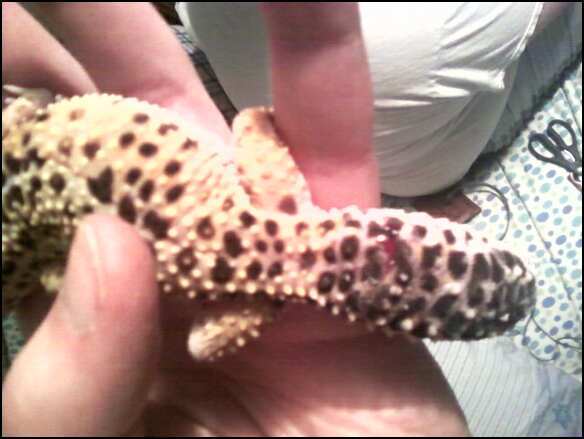 leopard gecko tail has a cut
Question
Geckos tail.
Hi, my name is Dawn and i have 2
leopard gecko tail has a cut
Question
Geckos tail.
Hi, my name is Dawn and i have 2
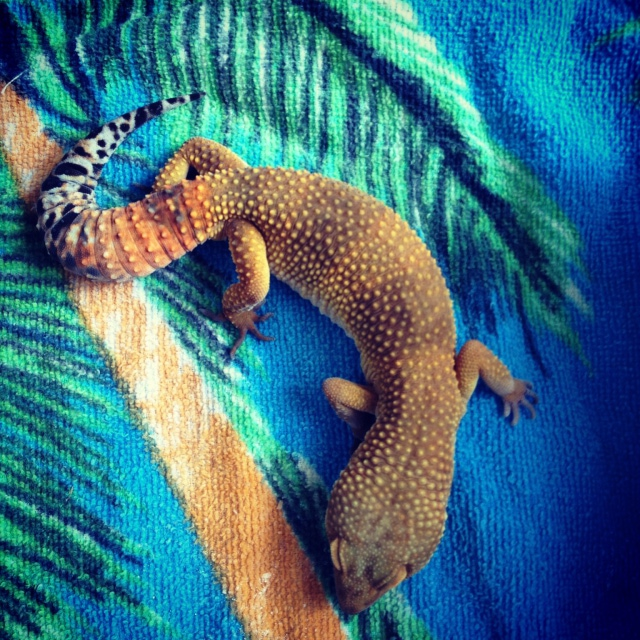 New gecko morph?
Question
Morph? Morph?
I picked up my thir
New gecko morph?
Question
Morph? Morph?
I picked up my thir
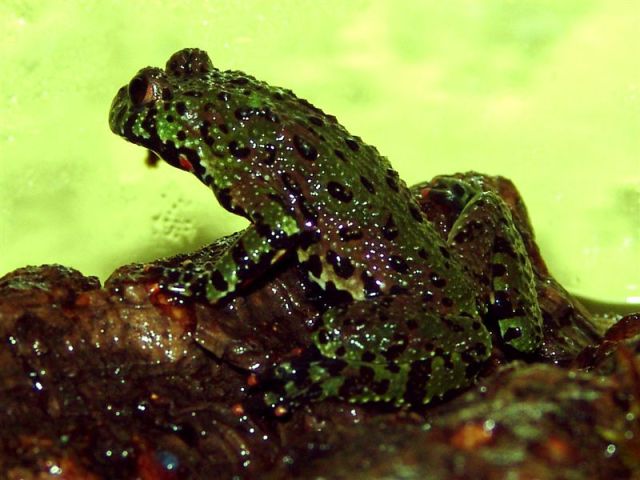 My water dragons enclosure and what they eat
QuestionQUESTION: Hi, partner recently had a baby and s
My water dragons enclosure and what they eat
QuestionQUESTION: Hi, partner recently had a baby and s
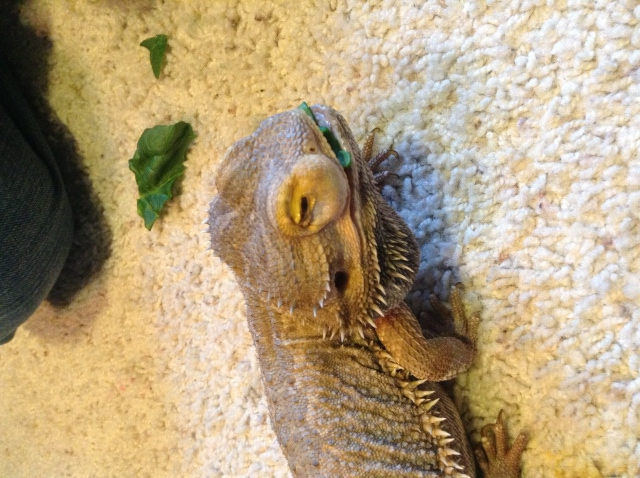 Rex hypovitaminosis A
Question
Rex Rex
This is the picture of hi
Rex hypovitaminosis A
Question
Rex Rex
This is the picture of hi
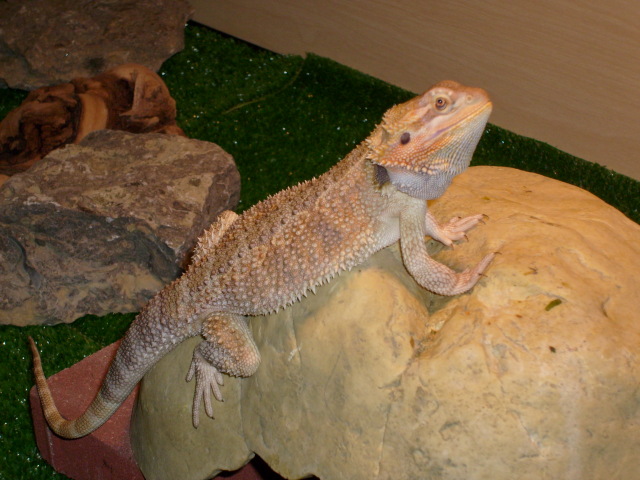 my first beardie
QuestionScooter
QUESTION: Hi! I have owned snake
my first beardie
QuestionScooter
QUESTION: Hi! I have owned snake